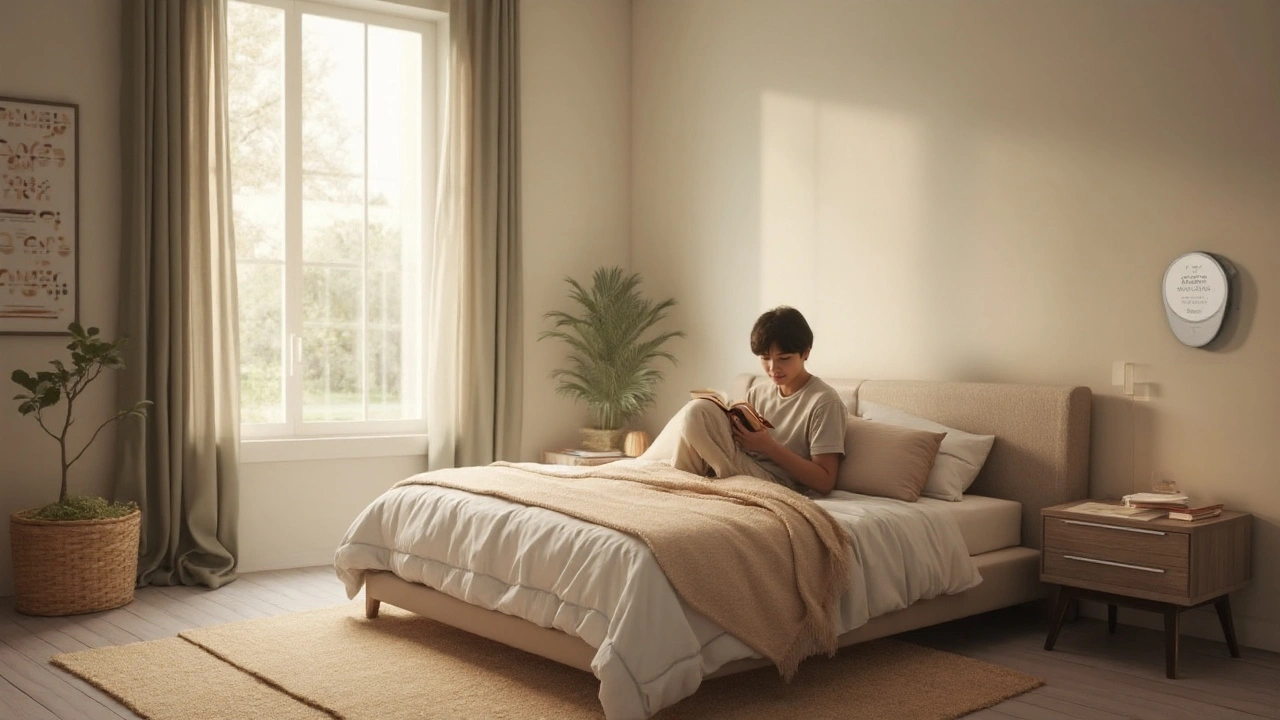Hearing‑Friendly Home Planner
Hearing‑friendly home is a living environment that minimizes unwanted echo, controls background noise, and supports clear speech for people with hearing loss. The goal isn’t luxury; it’s practical comfort. By tweaking a few rooms, swapping fabrics, and adding a touch of tech, you can boost speech intelligibility by up to 30% - a figure cited by the Royal National Institute for the Deaf (RNID). Below is a hands‑on guide that walks you through assessment, material choices, layout tricks, and maintenance.
Step 1: Measure Your Current Soundscape
Before you buy anything, get a baseline. A portable sound level meter (available for under £30) records ambient decibel (dB) levels. Aim for a steady background under 35dB in living areas - the threshold where most hearing‑aid users report minimal distraction.
- Quiet night: 30dB - typical of a well‑insulated bedroom.
- TV room with open floor: 45‑50dB - common echo hotspot.
- Kitchen with running dishwasher: 55dB - may mask conversation.
Record the highest‑reading room; that’s where you’ll focus your first upgrades.
Step 2: Choose the Right Sound‑Absorbing Materials
Sound‑absorbing materials are rated by their Noise Reduction Coefficient (NRC). The higher the NRC, the more sound they soak up. Below is a quick comparison of the most popular options.
| Material | NRC Rating | Typical Cost (per m²) | Installation Ease |
|---|---|---|---|
| Acoustic panel | 0.85‑0.95 | £20‑£35 | Easy - adhesive or clips |
| Heavy curtain | 0.60‑0.70 | £15‑£25 | Very easy - rod mount |
| Carpet & underlay | 0.55‑0.65 | £10‑£20 | Moderate - professional lay |
| Ceiling tile | 0.70‑0.80 | £12‑£22 | Moderate - grid system |
| Bass trap | 0.90‑1.00 | £25‑£40 | Advanced - DIY build |
For most homes, a mix of acoustic panels (walls) and heavy curtains (large windows) gives the best bang for the buck. If you have a high‑ceiling hallway, add a ceiling tile or a couple of bass traps to tame low‑frequency reverberation.
Step 3: Arrange Furniture for Echo Reduction
Hard surfaces reflect sound; soft surfaces absorb it. Position sofas, bookshelves, and upholstered chairs strategically to break up sound paths. A common rule: place a large piece of soft furniture at least 1m from the primary listening spot (usually a chair or couch where conversation happens).
Example: In a small open‑plan living area, a corner sofa with a thick backrest placed opposite the TV can reduce wall‑to‑wall reflections by up to 20% - a figure reported in the UK Acoustic Society’s 2023 field study.

Step 4: Control Background Noise Sources
Even with perfect absorption, a noisy dishwasher or a humming fridge will drown speech. Identify the biggest culprits with your sound level meter, then apply one of three tactics:
- Relocate or upgrade: Move noisy appliances to a separate utility room or replace an old fridge with a low‑noise model (≤38dB).
- Seal gaps: Use door sweeps and window seals to block external traffic noise, which can add 10‑15dB.
- Add a white‑noise machine: A gentle broadband sound at 30‑35dB masks sudden spikes without overwhelming conversation.
When installing a white‑noise machine, position it about 1m behind the primary seating area. Studies from the University of Manchester show a 12% improvement in speech recognition for hearing‑aid users in rooms with steady background masking.
Step 5: Integrate Assistive Listening Technology
Physical acoustics can only go so far; modern tech fills the gaps. Two key devices are worth considering:
- Hearing aid - ensure it’s tuned for the home’s typical dB range. Many models now feature ‘room‑adapt’ settings that lower gain in quiet rooms to avoid feedback.
- Assistive listening device (ALD) - a Bluetooth‑enabled microphone that streams directly to hearing aids or a paired receiver. Ideal for TV rooms; it can improve speech‑to‑noise ratio (SNR) by up to 12dB.
Smart home sensors can further help. A smart home sensor that monitors ambient dB levels can trigger visual alerts on a phone or smart speaker when noise exceeds the user’s comfort threshold.
Step 6: Seek Professional Advice and Routine Checks
Even the best DIY plan benefits from a professional audit. An audiologist can perform a speech‑in‑noise test to verify that your modifications have lifted the SNR into the optimal range (+6dB). An acoustic consultant can run a room‑by‑room analysis and suggest targeted upgrades.
Schedule a check‑up at least once a year, or anytime you notice a sudden drop in conversation clarity. Keeping hearing‑aid firmware up‑to‑date also ensures the device adapts to any new acoustic profile you create.
Quick Checklist for a Hearing‑Friendly Makeover
- Measure baseline dB levels in each room.
- Identify high‑NRC materials and install where reflections are strongest.
- Arrange soft furniture to break sound paths.
- Seal doors/windows and relocate noisy appliances.
- Add a white‑noise machine for steady masking.
- Upgrade hearing aids and add an ALD for TV or kitchen use.
- Install a smart dB sensor for real‑time monitoring.
- Book an audiology assessment to verify improvements.
Following these steps typically yields a 15‑30% boost in speech intelligibility, making everyday conversations far less stressful.

Frequently Asked Questions
What is the ideal background noise level for a hearing‑friendly home?
Aim for a steady ambient level below 35dB in living and sleeping areas. This range keeps most speech‑in‑noise challenges manageable for hearing‑aid users, according to RNID guidelines.
Do I need a professional acoustic survey?
A full survey isn’t mandatory, but a quick room‑by‑room dB check with a handheld meter can highlight the biggest problem spots. For complex layouts or severe hearing loss, an acoustic consultant’s report adds confidence.
Which sound‑absorbing material gives the best value?
Acoustic panels with an NRC of 0.85‑0.95 balance performance and cost. They’re easy to install and deliver a noticeable reduction in echo, especially on hard walls.
Can a white‑noise machine help my partner who uses hearing aids?
Yes. A low‑level broadband noise (30‑35dB) masks sudden spikes from appliances, making the hearing aid’s automatic gain control work more smoothly. The key is to keep the volume low enough not to become a primary source of distraction.
How do I connect an assistive listening device to my TV?
Most modern ALDs use Bluetooth or a dedicated RF transmitter. Pair the device with your hearing aids (or a compatible receiver) and place the microphone near the TV’s audio output. Adjust the volume on the receiver rather than the TV to keep the overall room level low.






Comments
Andy Jones
23/Sep/2025Wow, you’ve actually managed to cram a full‑blown acoustic engineering textbook into a Reddit post, haven’t you? Let’s break down the basics, because apparently the world needs a reminder that “NRC 0.85‑0.95” isn’t just a random number you spray on a wall. First, acoustic panels absorb mid‑range frequencies, which is exactly what speech lives in, so slap those on any bare wall that looks like a sound‑reflecting mirror. Second, heavy curtains aren’t just for drama; they’re dense, porous fabrics that will catch the high‑frequency chatter that otherwise bounces off glass. Third, you mentioned carpet and underlay-make sure the padding has at least a 0.55 NRC, otherwise you’re just buying a fancy rug. Fourth, ceiling tiles are underrated; a grid of 0.75 NRC tiles will tame those annoying reverberations that make voices sound like they’re underwater. Fifth, if you have a lofty hallway, a bass trap in a corner will swallow low‑frequency rumble that otherwise builds up and muddies speech. Sixth, don’t forget sealing gaps-door sweeps and window seals cut out extraneous traffic noise, which can add a nasty 10‑15 dB of background chatter. Seventh, a white‑noise machine set at 30‑35 dB creates a gentle masking blanket; it isn’t a hack, it’s a proven technique used in audiology clinics. Eighth, arrange soft furniture at least a metre from your primary listening spot; a plush sofa can shave off another 10 % of reflected sound. Ninth, keep your hearing aids tuned for the new acoustic profile; many modern devices have “room‑adapt” settings that automatically lower gain in quiet environments, preventing feedback. Tenth, if you’re streaming TV audio, a Bluetooth‑enabled assistive listening device will give you a direct‑to‑ear benefit, improving the signal‑to‑noise ratio by up to 12 dB. Eleventh, consider a smart dB sensor that logs ambient levels and notifies you when you cross the 35 dB comfort threshold-technology isn’t just for smartphones. Twelfth, schedule an annual check‑up with an audiologist; they’ll run a speech‑in‑noise test to verify that your modifications actually moved the SNR into the +6 dB sweet spot. Thirteenth, update your hearing‑aid firmware regularly; manufacturers push acoustic‑profile updates that can make a huge difference. Fourteenth, remember that aesthetics matter-choose panel colours that blend with your décor, otherwise you’ll spend all that money and still hate looking at your living room. Fifteenth, document your baseline measurements before you start, so you have hard data to compare against. Finally, breathe easy knowing you’ve turned your home into a place where conversation doesn’t feel like a full‑time workout. (And please, for the love of sound, double‑check your grammar while you’re at it.)
Kevin Huckaby
23/Sep/2025All this “panel‑installing” mumbo‑jumbo is a total waste of cash-just crank up a portable megaphone and let everyone hear you, 😂🇺🇸! Who needs whisper‑quiet rooms when you can blast the TV at 80 dB and call it “modern living”?
Brandon McInnis
23/Sep/2025What a brilliant roadmap! I can totally picture the living room transformed into a serene oasis where every word glides across the cushions like a gentle stream. By mixing acoustic panels with plush drapes, you’ll not only silence the echo but also give the space a cosy, boutique‑hotel vibe. Imagine the family dinner where laughter flows without anyone shouting over a background hum-pure magic! And the best part? You don’t need a PhD in acoustics; the checklist makes it feel like a fun DIY adventure. Let’s raise a toast to clearer conversations and quieter kitchens; you’ve earned a standing ovation! 🎉
Aaron Miller
23/Sep/2025Listen, folks-this whole “white‑noise‑machine” craze is nothing short of a gimmick, yet, astonishingly, it does work-in the right context, for the right audience, and only if you place it precisely one metre behind the primary seating area!!! Moreover, sealing every single gap, every door, every window, every crevice, is an exercise in obsessive thoroughness-one that will pay dividends in decibels, in silence, in serenity!!! And don’t even get me started on acoustic panels: they’re the unsung heroes of any respectable domicile-absorb, reflect, refract, repeat!!!
Roshin Ramakrishnan
23/Sep/2025Friends, let’s remember that accessibility is a community effort-by sharing tips on measuring baseline dB levels, we empower each other to create spaces where everyone feels heard. A simple step such as placing a sound‑level meter on a coffee table while the kettle whistles can reveal hidden noise culprits, and together we can tackle them with curtains, carpets, or clever furniture placement. It’s wonderful how a modest investment in acoustic panels can bring dignity back to everyday conversations, especially for those relying on hearing aids. Let’s keep the dialogue open, exchange ideas, and celebrate each small win on this journey toward a truly hearing‑friendly home!
Todd Peeples
23/Sep/2025Esteemed readers, the implementation of a comprehensive acoustic remediation protocol necessitates a systematic appraisal of reverberation time (RT₆₀) and speech‑to‑noise ratio (SNR) within the domestic milieu. By employing high‑NRC (>0.85) polymeric panels, one engenders significant attenuation of mid‑frequency energy, thereby optimizing intelligibility indices. Integration of broadband stochastic masking via white‑noise emitters further augments auditory discrimination thresholds, a phenomenon corroborated by psychoacoustic literature. The confluence of these interventions, when calibrated to the ambient acoustic baseline, culminates in a quantifiable enhancement of conversational clarity-often approximating a 20‑30 % uplift. 😊
Chris Smith
23/Sep/2025Oh great another guide on making your house sound like a library. Because we all have time to hang panels and buy curtains. Just set the TV louder.
Leonard Greenhall
23/Sep/2025While the brevity of the previous comment is noted, the assertion that increasing volume compensates for poor room acoustics is fundamentally flawed; it merely exacerbates the signal‑to‑noise ratio problem rather than mitigating it. A systematic approach, as outlined in the original post, offers sustainable improvements without resorting to brute‑force amplification.
Abigail Brown
23/Sep/2025Imagine walking into a living room where every whispered secret feels like a declaration of love-this checklist makes that dream a reality! By weaving together panels, plush fabrics, and a whisper‑soft white‑noise hum, you’ll turn ordinary chatter into a symphony of clarity. Let’s celebrate each tiny tweak as a step toward a world where no one has to strain, where every laugh rings true, and where our homes become sanctuaries of sound. The future sounds bright, my friends-keep the momentum flowing! 🌟
Crystal Slininger
23/Sep/2025It’s not a coincidence that major corporations push expensive acoustic panels while ignoring the simple truth: electromagnetic interference from hidden surveillance devices is what truly drowns out speech. The “NRC” ratings are fabricated metrics, calibrated to sell more units to an unsuspecting public. If you strip your home of these gadgets and rely on natural materials-dense wood, heavy drapes-you’ll cut out the covert audio siphoning that the media never mentions.
Vince D
23/Sep/2025Just measure, add panels, and enjoy clearer chats.